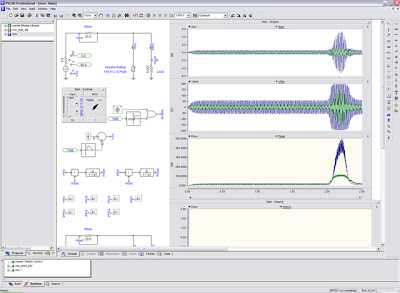PSCAD (Power Systems Computer Aided Design) is a time domain simulation software for analyzing transients in electrical networks. It is a collection of programs, providing a graphical Unix-based user interface to electromagnetic transients program (EMTP). It is also known as PSCAD/EMTDC. EMTDC (Electromagnetic Transients with DC Analysis) was first developed in 1976 and has been constantly evolving in its scope and capabilities. It is an integral part of PSCAD as it is the library of power system component models and procedures, which establish the simulation software provided with PSCAD. Together they provide a fast, flexible and accurate solution for the efficient time-domain program for simulating a variety of electrical power system transients and control networks.
Engineers and end-users can now harness the features of EMTDC through the user-friendly PSCAD interface. This integrated visual environment supports all aspects of conducting a simulation including circuit assembly, run-time control, analysis and reporting.
Engineers and end-users can now harness the features of EMTDC through the user-friendly PSCAD interface. This integrated visual environment supports all aspects of conducting a simulation including circuit assembly, run-time control, analysis and reporting.
In other words, PSCAD is a software that make use of intelligent techniques to computerize the power quality evaluations for improved accuracy and efficiency since manual analysis takes considerable time and would require special knowledge.
 |
| PSCAD (Power Systems Computer Aided Design) |
Capabilities
PSCAD is a professional’s tool, which can simulate control systems and complex networks. It provides a very flexible and effective way for testing and simulation for Power Quality, especially transients and harmonics. Other capabilities include, but not limited to:
- Enable circuit to be schematically constructed
- Create new custom components
- Run a simulation
- Analyze results
- Manage data in a completely integrated graphical environment
PSCAD solves the differential equations of the power system and its controls in the time-domain. The results are computed as instantaneous values in time but can be converted to phasor magnitudes and angles by the true RMS meters and/or FFT spectrum analyzers.
Applications
PSCAD assists engineers in planning, designing, commissioning, operation, preparation of specifications, research and teaching. The following are studies generally performed through PSCAD:
Ø Assess the maximum energy in a surge arrester for a given disturbance.
Ø Investigate instabilities due to harmonic resonance or control interactions.
Ø Evaluate the harmonics generated by a SVC, HVDC link, STATCOM, machine drive (virtually any power electronic device) using accurate models of thyristors, GTOs, IGBTs, diodes, etc. along with the detailed control systems, analog or digital.
Ø Modeling of STATCOMs with their detailed control models.
Ø Study interactions between SVCs, HVDC and other non-linear devices.
Ø Investigate overvoltages in a power system due to a fault or breaker operation. Transformer non-linearities are a critical factor and are represented.
Ø Find overvoltages in a power system due to a lightning strike. This simulation would be performed with a very small time step (nanoseconds).
Ø Conduct insulation coordination studies.
Ø Tune and design control systems for maximum performance.
Ø Investigate the Sub-Synchronous Resonance (SSR) effect when a machine and a multi-mass turbine system interact with series compensated lines or power electronic equipment. Control systems can also be modified to investigate possible SSR mitigation methods.
Ø Examine the pulsing effects of diesel engines and wind turbines on the electric network.
Ø Variable speed drives of various types including cycloconverters and transportation and ship drives.
Ø Industrial systems including compensation controllers, drives, electric furnaces and filters.
Ø Capacitor Switching transients.
Ø Assess the transient effects of distributed generation such as wind and micro-turbines on the grid, including feeds to isolated loads.
Ø Effect of transmission line imbalances on the system performance during emergencies.
Advantages and Disadvantages
PSCAD’s benefits are summarized as follows:
- A flexible, powerful and relatively cheap simulation program.
- Maximize speed and provide memory efficient storage.
- Useful in analysis of steady-state system response.
- Wide context sensitive HTML HELP system.
PSCAD has also some limitations and shortcomings such as:
- Supports only time plots, not able to plot harmonic magnitude or phase versus frequency.
- Graphs plotted could not be exported as a picture file.
- Precise information of power system needed to accurately run the simulation.
Links:


1 comment:
A good blog with exciting content, that's what I need. Thank you for keeping this site it services company
Post a Comment